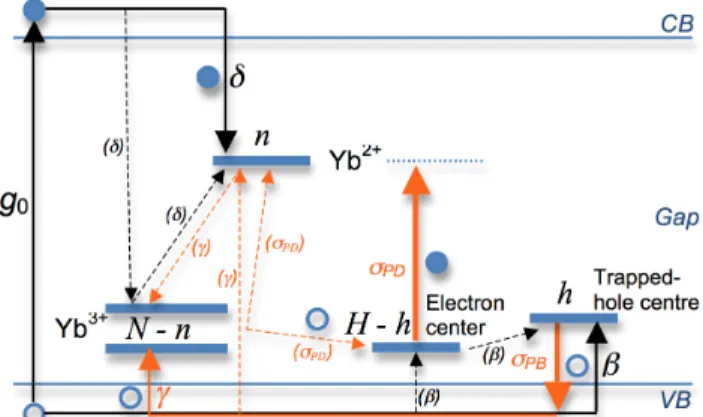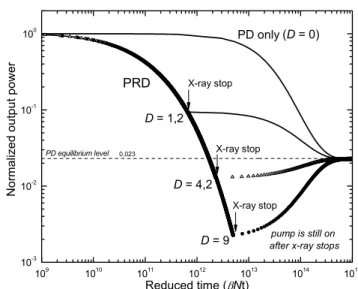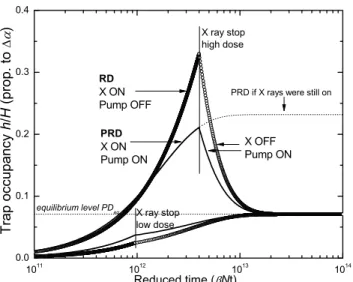HAL Id: hal-01307618
https://hal.archives-ouvertes.fr/hal-01307618
Submitted on 26 Apr 2016
HAL is a multi-disciplinary open access
archive for the deposit and dissemination of
sci-entific research documents, whether they are
pub-lished or not. The documents may come from
teaching and research institutions in France or
abroad, or from public or private research centers.
L’archive ouverte pluridisciplinaire HAL, est
destinée au dépôt et à la diffusion de documents
scientifiques de niveau recherche, publiés ou non,
émanant des établissements d’enseignement et de
recherche français ou étrangers, des laboratoires
publics ou privés.
A sufficient model of the photo-, radio-, and
simultaneous photo-radio-induced degradation of
ytterbium-doped silica optical fibres
Franck Mady, Jean-Bernard Duchez, Yasmine Mebrouk, Mourad
Benabdesselam
To cite this version:
Franck Mady, Jean-Bernard Duchez, Yasmine Mebrouk, Mourad Benabdesselam. A sufficient model
of the photo-, radio-, and simultaneous photo-radio-induced degradation of ytterbium-doped silica
optical fibres. 10th International Symposium on SiO2, Advanced Dielectrics and Related Devices, Jun
2014, Cagliari, Italy. �hal-01307618�
A sufficient model of the photo- , radio-, and simultaneous photo-radio-induced
degradation of ytterbium-doped silica optical fibres
Franck MADY, Jean-Bernard DUCHEZ, Yasmine MEBROUK, Mourad BENABDESSELAM
University of Nice Sophia Antipolis, Laboratoire de Physique de la Matière Condensée
CNRS UMR 7336, Parc Valrose, 06108 NICE cedex 2, France
Preference: oral, topic : radiation effects (on silica fibres, harsh environment)
ABSTRACT
We propose a physical model of photo-, radio-, and simultaneous photo-radio-darkening of Yb-doped silica optical fibers. This work is complementary to the submission by J-B. Duchez et al., also in this conference, which reports a detailed characterization of the interplay between the pump (photo-darkening) and an external ionizing radiation (radio-darkening). The model predictions are in full agreement with data on photo-darkening and with all of the experiments reported in the Duchez’s work. PACS Keywords: Fiber optics, Radiation effects on optical elements, devices and systems.
1 INTRODUCTION
A detailed characterization of simultaneous photo-radio-darkening (PRD) is proposed in this conference by J-B. Duchez et al.. The present complementary work presents a model based on the minimal physical mechanisms (free of any semi-empirical law or parameter) that are shown to be
sufficient to reproduce all of the experimental features
reported in literature for photo-darkening (PD), and in the Duchez’s abstract for radio-darknening (RD) and PRD. Refinements could be proposed to improve, e.g., the quantitative kinetics. Such a successful agreement between a wide variety of experimental features and the model has important consequences in the understanding and assessment of the YDF resistance. Even if PD and RD mitigation routes have been found (as phosphorus co-doping for PD or cerium co-co-doping for PD and RD), our work sets a novel and proper understanding framework, beyond empirical recipes.
2 MODEL AND RESULTS
The physical processes of PD and RD build-ups are still rather controversial. The experimental validation of the present model provides a strong support of the retained mechanisms and should put an end to the main controversies. In [1], we concluded that the RD of X-ray irradiated YDF originated from the reduction of Yb3+ ions,
forming Yb2+ ions and trapped holes. We also highlighted that trapped-hole-centres resulting from PD were identical
to those produced by RD. At last, we showed that the thermal PD and RD bleaching was due to the release of trapped holes and their subsequent recombination to Yb2+
ions. These findings are consistent with the proposal by the Engholm’s team that PD is due to an Yb3+ to Yb2+
conversion, again with hole trapping, upon absorption of a UV photon (resulting from the cooperative de-excitation of several excited Yb3+ ions) into the charge transfer (CT)
bands of Yb3+ ions [2-4]. Darkening can be bleached at 355
nm [5], 543 nm [6], and 915 nm [7]. If photobleaching (PB) results from the photoionisation (PI) of trapped holes, this variety of energies suggests that PI takes place between a localized trapping state and the valence band (VB), and that trapping states involved in darkening may start around ∼1.26 eV (980 nm) above the VB (consistent with [8,9]). Based on these hypotheses, we propose the model of Fig. 1, cast into the form of an energy level scheme.
Fig. 1. Energy level scheme of the model. RD transitions
in black, PD and PB ones in orange. Thick arrows show the relevant energy transitions. Dashed arrows just
illustrate routes of valence changes.
The ionizing radiation, responsible for RD, generates electron-hole pairs at a rate g0, representative of the dose
rate. Electrons injected in the conduction band (CB) can be trapped by Yb3+ ions (initial density N) to form Yb2+ ions
(density n), whereas holes get trapped on gap states to form trapped-hole colour centres (H states occupied by h holes). In this minimal model, we deal with a single trap, but a distribution of trapped-hole centres is required to reproduce accurate darkening kinetics. Thermal hole detrapping is also neglected here, but it could be added as a refinement. The pump is responsible for the direct CT of holes from
Yb3+ ions to traps, as shown by the σ
PD transition, and the
trapped-hole state is shared with RD [1]. Following [3], we do not consider hole transfer to the valence band because this CT requires a higher energy and is much less probable in the case of PD since this energy is gathered from several excited Yb3+ ions. CT also increases the densities of Yb2+
ions (n) and colour centres (h). Both species contribute to the excess loss in their respective absorption bands. PI of trapped-hole centres corresponds to the σPB transition.
Released holes can recombine to Yb2+ ions (PB). Transient
carrier populations in the bands are always small so n and h are virtually identical, proportional to the excess absorption coefficient. We consider that 3 cooperative de-excitations of Yb3+ ions are necessary to reach the first CT absorption
band [3]. If the ionization energy of trapped-hole states is around 1.3 eV [8,9], it also takes the energy of k = 2 or 3 excited Yb3+ ions to reach a significant PI cross-section.
Transitions of Fig. 1 can be rationalized by a set of coupled non-linear differential equations and solved numerically to provide time-resolved PD, RD or PRD. Because of PB, simulated PD and PRD always reach a stationary level at long irradiation times, in agreement with data ([7] and Duchez’s submission). The RD evolution is determined by a few ratios: r = N/H, α = β/γ, θ = δ/γ. PD and PRD are also
controlled by the Yb3+ ions inversion rate x
inv and, notably,
σPD/σPB. The model was first checked against literature data
for pure PD (g0 = 0). It was found to reproduce all the PD
features reported by Jetschke et al. [7], in particular the linear dependence of the PD equilibrium level (PDEL) on the inversion rate xinv. We established that, below trap
saturation, 2 physical cases lead to this linearity. If PI involves 2 excited Yb3+ ions, the PDEL is proportional to
xinv if α ≥ 1. Stationary hole trap filling (h/H) and
conversion rate of Yb3+ ions (n/N) are then:
€ h H = r n N = N r xinv α σPD σPBNVτ , for k = 2. (1) If PI involves 3 excited ions, the PDEL increases linearly with xinv if α < 1 and α/r < h/H < max(1,1/r). Then:
€ h H = r n N = N r xinv σPD σPBNV , for k = 3. (2) In (1) and (2), τ is the non-radiative lifetime of Yb3+ ions
and Nv is the equivalent density of states in the VB. The
dimension of the σPB coefficient depends on k. To decide
between these 2 cases, it would be interesting to examine the experimental dose rate dependence of RD in YDF. We indeed showed recently [10] that trap systems with small α
ratios should present much higher dose rate effects than those with α ≥ 1 (study currently in progress). Whatever the case, the general behaviour of the calculated PRD is always the same. In Fig. 2 to 4, we simulated the same protocols as in the Duchez’s experiments, here for k = 2, α = 1 (other parameters are not discussed in this short article). Fig. 2
presents the transmission decay in a PRD sequence, at various doses, followed by PD or PB under the sole action of the pump. It illustrates the crucial role of the PDEL by showing that the primary action of the pump (PD or PB)
depends on the ionizing dose! The pump is mainly
responsible for PD as long as the dose has not degraded the system below the PDEL. Then it essentially leads to PB (the reduced dose D is the ratio of the number of electron-hole pairs created by the ionizing dose to N).
Fig. 2. Simulated transmission decays at various reduced
doses D and the role of the pump after X-ray stops In Fig. 3 (similar to Fig. 3 in the Duchez’s work), 2 ionizing doses have been imparted with or without pump (PRD or RD) before leaving the pump acting alone. At the end of the dose absorption, the pump has slowed-down darkening in PRD, compared with RD, at doses yielding a PRD level above PDEL. It has conversely enhanced darkening at doses where the PRD level is below the PDEL. At high doses (longer irradiation times, dotted line in Fig. 3), the PRD level exceeds PDEL but reaches a plateau at a given dose due to the balancing PB pump action. Higher doses above this threshold will not be more harmful to the YDF. Increasing the inversion rate will increase the PDEL, but also the “restoring force” of the pump above the PDEL: the PRD equilibrium level will get closer to the PDEL and the PRD saturation level may decrease. Such a radio-hardening effect by pumping will be enhanced in PD-resistant YDF (low PDEL even at high xinv). The effect of a decreasing
dose rate is illustrated in Fig. 4, where simulations of the fractional irradiation experiments displayed in Fig. 4 of the Duchez’s abstract are presented. Calculations are in very good agreement with data, except maybe for the decay kinetics after X-ray shuts-down (to be improved by a model refinement). We added, in dashed lines, the PRD obtained for permanent irradiations, the constant dose rate being equal to the mean dose rate achieved in the 3- and 6-fraction irradiations. We also display the PRD obtained for the same dose, but with a constant dose rate of one tenth and one thousandth of the 6-fraction mean dose rate.
Fig. 3. Simulated degradation under X rays for RD and PRD
and post-x-rays evolution due to the pump
By exploring, through a validated simulation, such low dose rates that are not achievable in practise (too long irradiations), we demonstrate that the PRD level decreases with the dose rate (at high dose) and that it saturates to its minimal value, equal to the PDEL, at very low dose rates. This is an important conclusion, notably as regards the use of YDF in space-based applications (PD-resistant YDF will be PRD resistant!)
Fig. 4. Simulation of PRD for a dose given in 1, 3 and 6
fractions and comparison with permanent irradiations at similar mean dose rates. Inset: the same in log-log scales.
3 REFERENCES
[1] F. Mady, M. Benabdesselam and W. Blanc, Opt. Lett., 35, 3541-3543, 2010.
[2] M. Engholm, L. Norin and D. Aberg, Opt. Lett., 32, 3352-3354, 2007.
[3] M. Engholm and L. Norin, Opt. Express, 16, 1260-1268, 2008.
[4] S. Rydberg and M. Engholm, Opt. Express, 21, 6681-6688, 2013.
[5] I. Manek-Höninger et al., Opt. Express, 15, 1606-1611, 2007.
[6] A.D. Guzman-Chávez et al., Laser Phys. Lett., 4, 734-739, 2007.
[7] S. Jetschke, S. Unger, U. Röpke, and J. Kirchhof, Opt. Express, 15, 14838-14843, 2007.
[8] M. Leich at al., Opt. Express, 17, 12588-12593, 2009. [9] M. J. Söderlund et al., Opt. Lett., 34, 2637-2639, 2009. [10] F. Mady et al., IEEE Trans. Nucl. Sci., 60, 4341-3448, 2013.


